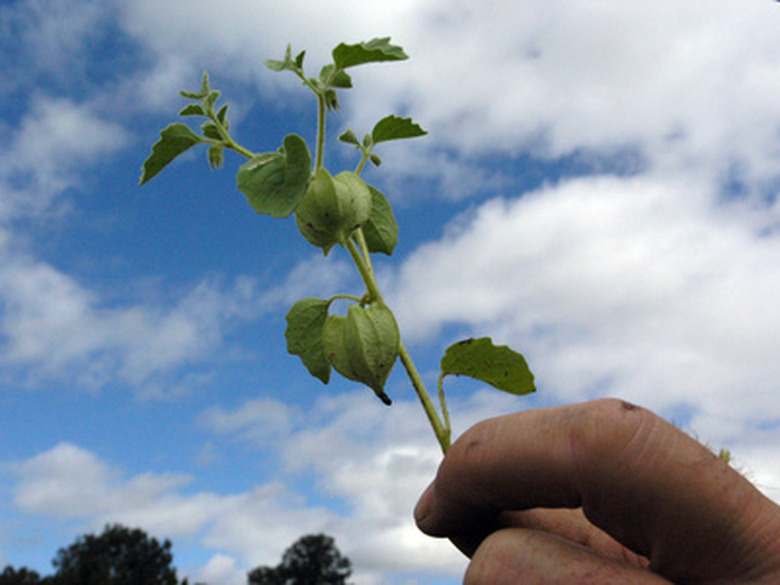Tomatillo Plant Identification
Mature tomatillos (genus Physalis, groundcherries) are easily identified by the "paper lantern" appearance of the calyx remnant that encases the fruit. The calyx may be yellow, orange or purple. The berry inside resembles a small tomato. Physalis seedlings have lance-shaped cotyledons 3 to 12 millimeters long and weak taproots with fibrous lateral branches. Physalis are short and sprawling. They bear 12- to 23-millimeter-diameter pendant flowers in the northern hemisphere from June through October. Leaves of the 27 species of physalis vary from ovate and heart-shaped to lanceolate.
- Mature tomatillos (genus Physalis, groundcherries) are easily identified by the "paper lantern" appearance of the calyx remnant that encases the fruit.
- Leaves of the 27 species of physalis vary from ovate and heart-shaped to lanceolate.
Edible Tomatillo
Commercial and home garden tomatillos (Physalis philadelphica or ixocarpa) are a summer annual native to Mesoamerica, where they have been cultivated for millennia. The 8- to 15-millimeter-diameter flowers are yellow with green-blue to purple central spots. The anthers have a slightly blue tint and are twisted. Leaves are ovate to diamond-shaped with margins entire or somewhat toothed. The mature fruit completely fills the calyx.
Wright Groundcherry
The Wright groundcherry (Physalis acutifolia) is a summer annual native to the southwestern United States from Louisiana to California and invasive over a wider range. The 15- to 23-millimeter-diameter cream to yellow-colored flowers have a slight green tint and a darker yellow center. The anthers have a bluish tint. Leaves vary from ovate to elliptical to lance-shaped with toothed margins. Like all physalis, it prefers disturbed ground in open or cultivated fields.
- Commercial and home garden tomatillos (Physalis philadelphica or ixocarpa) are a summer annual native to Mesoamerica, where they have been cultivated for millennia.
- The anthers have a slightly blue tint and are twisted.
Lanceleaved Groundcherry
Like its close relative Jimson weed, lanceleaved groundcherry (Physalis lanceifolia) can be toxic to livestock if it is harvested with hay. Animals avoid it in pastures. Lanceifolia is a yellowish green summer annual with 5- to 10-millimeter diameter, evenly yellow to greenish yellow flowers. The anthers are bluish. The leaves are narrow to broadly lanceolate. Leave margins may be entire or toothed.
Longleaf Groundcherry
The longleaf groundcherry (Physalis longifolia) is native to the continental U.S. and eastern Canada. This perennial is a noxious weed that propagates from creeping roots, as well as bearing 12- to 22-millimeter diameter, cream to yellow flowers with purple center spots or veins.
- Like its close relative Jimson weed, lanceleaved groundcherry (Physalis lanceifolia) can be toxic to livestock if it is harvested with hay.
Grape Groundcherry
Grape groundcherry (Physalis viscose) is native to Bolivia, Argentina and Paraguay and is a perennial, toxic, noxious weed in the United States. The plant is moderately hirsute with multi-branched hairs. Viscosa can propagate from creeping roots. Flowers are yellow with darker yellow centers.
Why Identify
Gardeners who have a favorite salsa recipe for their garden-variety tomatillos may not be aware that even edible tomatillos can be an invasive, noxious weed in Australia, California, Brazil and Hawaii and other locations. Tomatillos are also on USDA's interstate quarantine list as carrying pale cyst nematode, which can destroy crops of tomatillo's close relative, the potato. Wild tomatillos in Florida carry a spotted wilt virus, which endangers crops of another close relative, the tomato. All Physalis vegetative parts are toxic, and in some species the fruits may be toxic also.
- Grape groundcherry (Physalis viscose) is native to Bolivia, Argentina and Paraguay and is a perennial, toxic, noxious weed in the United States.
- All Physalis vegetative parts are toxic, and in some species the fruits may be toxic also.
